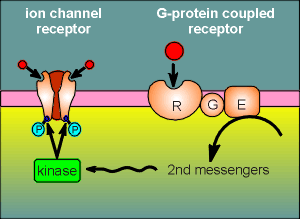 It was noted that there were several serines and threonines on intracellular
loops of the various subunits.
It was noted that there were several serines and threonines on intracellular
loops of the various subunits. It was noted that there were several serines and threonines on intracellular
loops of the various subunits.
It was noted that there were several serines and threonines on intracellular
loops of the various subunits.
Serines and threonines are the sites of phosphorylations through enzymes called kinases.
The enzymatic activity of kinases are regulated by so-called second messengers, such as cyclic AMP.
The production of second messengers is regulated by enzymes (E in the figure) which in turn are regulated by G-protein coupled receptors, which in turn are regulated by membrane bound receptors (the G-protein, G, makes the coupling between the receptor and the enzyme).
In the concept of a regulatory domain, phosphorylation of the ion channel receptor affects the functioning of the receptor (perhaps making it more sensitive or less sensitive to neurotransmitter).
In this way neurotransmitters or neuropeptides that work through G-protein coupled receptors (large red balls) can effect how a cell responds to other neurotransmitters working through ion channel receptors (small red balls).
This type of mechanism is sometimes referred to as "cross-talk" between receptor mechanisms.